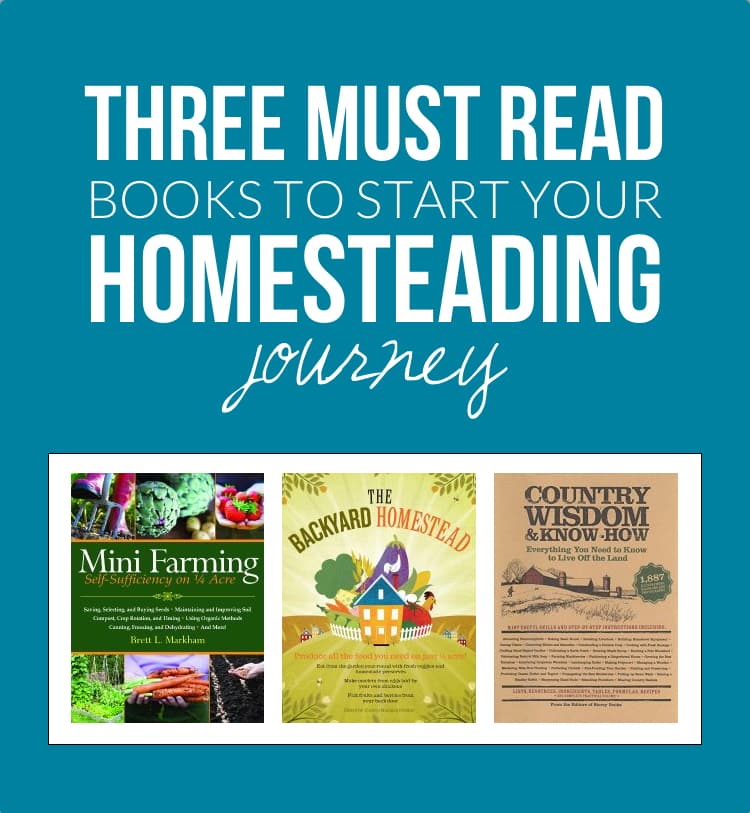I still consider myself very new to homesteading despite the fact that I think you can truly consider yourself a homesteader in a tiny apartment. We had a small “garden” in our duplex and we enjoyed cooking fresh, local food – but that was about the extent of it. But when we ditched city living for the country, I knew it was time to really learn about homesteading and how to make it happen with the land we had. So I did tons of reading and ended with three must read books that are the perfect way to start your homesteading journey.
The biggest reason I love all three of these books is because they don’t focus on the “go big or go home” mentality. All of them provide tips that can be used by apartment dwellers, but they expand beyond that to be beneficial for those with the rolling acres I wish we had, too. So even if you haven’t been able to ditch the city like we did, but you want to become a little bit more self-sufficient – I’d highly recommend checking out these books to start your homesteading journey!
This was the first book I grabbed before I really got into the idea of homesteading and I fell in love with it immediately. I saw it at Barnes and Noble and spent some time browsing it in store before heading home (and promptly buying it online at nearly half the price.) If you don’t have much (or any) land, this is the one to get! There are tons of things that you can do without owning a house or land.
About The Book (from Amazon.com)
Reminiscent in both spirit and design of the beloved Whole Earth Catalog, Country Wisdom & Know-How is an unprecedented collection of information on nearly 200 individual topics of country and self-sustained living. Compiled from the information in Storey Publishing’s landmark series of “Country Wisdom Bulletins,” this book is the most thorough and reliable volume of its kind. Organized by general topic including animals, cooking, crafts, gardening, health and well-being, and home, it is further broken down to cover dozens of specifics from “Building Chicken Coops” to “Making Cheese, Butter, and Yogurt” to “Improving Your Soil” to “Restoring Hardwood Floors.” Nearly 1,000 black-and-white illustrations and photographs run throughout and fascinating projects and trusted advice crowd every page.
This is the first book that made me realize that we didn’t need to have the house with acre upon acre around us. It shows you different setups you can have depending on the amount of land that you have and provides endless information on turning your backyard into the perfect food source for your family.
About The Book (from Amazon.com)
Put your backyard to work! Enjoy fresher, organic, better-tasting food all the time. The solution is as close as your own backyard. Grow the vegetables and fruits your family loves; keep bees; raise chickens, goats, or even a cow. The Backyard Homestead shows you how it’s done. And when the harvest is in, you’ll learn how to cook, preserve, cure, brew, or pickle the fruits of your labor. From a quarter of an acre, you can harvest 1,400 eggs, 50 pounds of wheat, 60 pounds of fruit, 2,000 pounds of vegetables, 280 pounds of pork, 75 pounds of nuts.
For those that have a black thumb like I do, THIS is the book for you. Also, if you’re looking to turn your land into a mini farm-stand – this is a great introduction to it. Page after page of things to know about gardening and so much more are packed into this book.
About The Book (from Amazon.com)
Mini Farming describes a holistic approach to small-area farming that will show you how to produce 85 percent of an average family’s food on just a quarter acre—and earn $10,000 in cash annually while spending less than half the time that an ordinary job would require. Even if you have never been a farmer or a gardener, this book covers everything you need to know to get started: buying and saving seeds, starting seedlings, establishing raised beds, soil fertility practices, composting, dealing with pest and disease problems, crop rotation, farm planning, and much more. Because self-suffciency is the objective, subjects such as raising backyard chickens and home canning are also covered along with numerous methods for keeping costs down and production high. Materials, tools, and techniques are detailed with photographs, tables, diagrams, and illustrations.
do you consider yourself a homesteader?
what are your favorite homesteading resources?
[Tweet “Wanting to start your homesteading journey? Check out these three books first!”]




